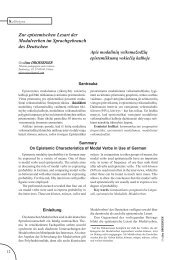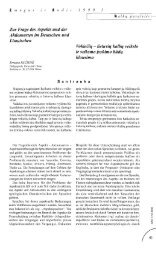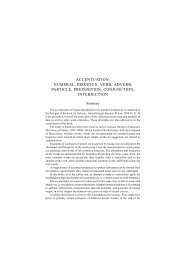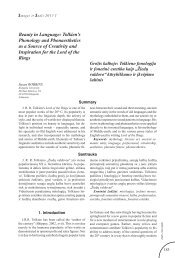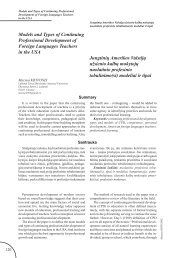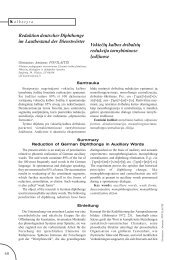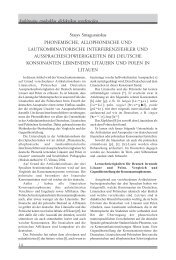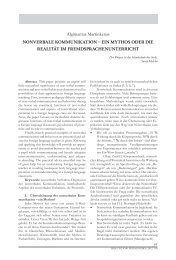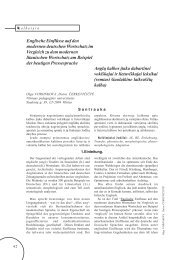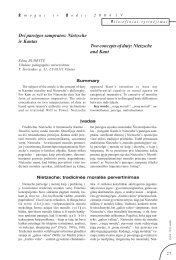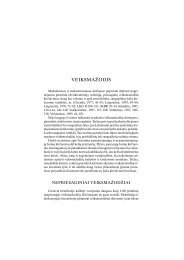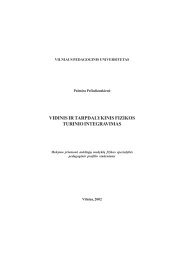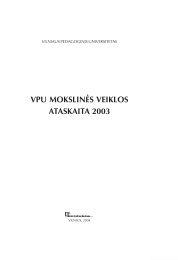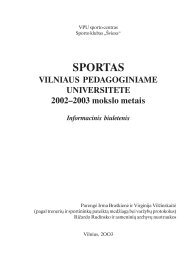visas tekstas - VPU biblioteka - Vilniaus pedagoginis universitetas
visas tekstas - VPU biblioteka - Vilniaus pedagoginis universitetas
visas tekstas - VPU biblioteka - Vilniaus pedagoginis universitetas
Create successful ePaper yourself
Turn your PDF publications into a flip-book with our unique Google optimized e-Paper software.
8<br />
Differential Acoustical Cues for Palatalized vs<br />
Nonpalatalized Prevocalic Sonants in Lithuanian<br />
The lowest values for the F2 locus in nonpalatalized<br />
cases were found for [m], followed by [l], [n],<br />
and [r]. This is not surprising since this succession<br />
corresponds to the step-by-step posterior movement<br />
of the constriction; from labials to alveolars or postalveolars,<br />
i.e., in a sense, a plain [r] is more ‘palatalized’<br />
than a plain [m]. What is more interesting is that<br />
dental [l] shows a statistically negligible difference<br />
from labial [m]. A possible explanation is that, at least<br />
for the speaker examined, the corresponding places<br />
of constriction do not differ much, and, in the case<br />
of [l], the tongue makes a significant excursion to<br />
the uvula or lower, thus lowering F2 (refer to Figure<br />
1). This articulatory difference is also reflected in<br />
the significant rise of F3 for [l] for the same reasons<br />
(see the rise of F3 when the (secondary) constriction<br />
moves to the uvula or lower, Figure 1).<br />
In addition, plain (nonpalatalized) [n] seems more<br />
retracted, i.e., moved into the direction of apicoalveolar<br />
position, compared to [l].<br />
For palatalized consonants, F2 loci show the<br />
highest values for [n’], followed by [r’], [l’], and<br />
[m’]. Thus [n’] is the most ‘soft’, and this can be<br />
ascertained simply audially. It results from the natural<br />
‘comfortable’ configurations of the tongue, which<br />
differ according to the different consonants (here we<br />
will not discuss this issue in detail).<br />
More information could be extracted from Figure<br />
2. Here we will limit ourselves to two additional observations.<br />
First, for [m’], a certain separate subclass<br />
characteristic of high F2s and F3s is formed. It is<br />
mostly associated with a distinct change of articulation<br />
in [m’ė] or [m’i]-type syllables ([m’] becomes<br />
extremely palatalized – at least, in the case of the<br />
speaker examined). Second, F2s for [r] and [r’] are<br />
not separated as much as for other consonants; even<br />
a slight overlap is registered. Inter alia, it seems that<br />
sometimes the speaker tends to ‘strengthen’ [r’]s,<br />
making them harder.<br />
One can expect that the impact of the place of<br />
articulation onto loci should be similar for different<br />
homorganic sounds. For instance, most probably,<br />
F2 loci for homorganic sonants and stops should<br />
coincide. Loci for stops have been examined in<br />
numerous studies; Figure 3 presents a comparison<br />
with the evaluations for stops made by Kewley-Port<br />
(1983).<br />
At first glance, it might seem that the F2 values<br />
for nonpalatalized sonants in the present study are<br />
unnaturally low. However, we should remember that<br />
Kewley-Port examined English consonants. In the<br />
Lithuanian case, the distinction between palatalized<br />
and nonpalatalized consonants is made stronger, thus<br />
Diferenciniai akustiniai palatalizuotų ir<br />
nepalatalizuotų prevokalinių lietuvių kalbos sonantų<br />
požymiai<br />
the F2 loci for plain consonants are moved to lower<br />
values, in a sense, to keep a distance from their palatalized<br />
counterparts. In English, palatalization does<br />
not form opposite consonant pairs. For the Lithuanian<br />
ear, English alveolar stops sound semipalatalized,<br />
and Figure 3 visualizes this phenomenon.<br />
Figure 3. Left: F2 loci for prevocalic sonants (higher:<br />
palatalized; lower: nonpalatalized). Medians (diamonds)<br />
Figure 3. Left: F2 loci for prevocalic sonants (higher: palata<br />
and interquartiles (vertical lines) are depicted. Right:<br />
nonpalatalized). rough evaluations Medians for stops; (diamonds) after Kewley-Port, and interquartiles 1983. (vertical lines)<br />
Right: rough evaluations for stops; after Kewley-Port, 1983.<br />
Effect of vowels (regressive<br />
coarticulation)<br />
At first glance, it might seem that the F2 values for nonpalatalized<br />
present study are unnaturally low. However, we should remember tha<br />
examined It is known English that loci consonants. are far from In the invariant; Lithuanian they case, the distinc<br />
depend palatalized on and the nonpalatalized phonetic context consonants (for instance, is made stronger, see thus the F2<br />
the typical work by Öhman (1966)). One can derive<br />
consonants are moved to lower values, in a sense, to keep a distan<br />
the loci frequencies as the functions ‘of the vowel’s<br />
own<br />
palatalized<br />
intrinsic,<br />
counterparts.<br />
target formant<br />
In English,<br />
frequency’<br />
palatalization<br />
(‘locus<br />
does not form oppo<br />
equations’; pairs. For the Howie, Lithuanian 2001, ear, 2). English Figure alveolar 4, in the stops manner sound semipalatalized<br />
similar visualizes to the this one phenomenon. presented by Öhman, demonstrates<br />
this dependence (on the succeeding vowels) extracted<br />
from the data examined in the present study. The<br />
tense (‘long’) Effect and of vowels lax (‘short’) (regressive vowels coarticulation) are combined<br />
into joint classes. It should be noted that, generally,<br />
back vowels It is known result that in loci lower are far F2 from loci invariant; compared they to depend on the ph<br />
front<br />
(for<br />
vowels.<br />
instance,<br />
However,<br />
see the typical<br />
some<br />
work<br />
permutations<br />
by Öhman<br />
among<br />
(1966)). One can d<br />
vowels are also noticeable. This has several explana-<br />
frequencies as the functions ‘of the vowel’s own intrinsic, target form<br />
tions; here we will mention only two of them. First,<br />
certain (‘locus Lithuanian equations’; Howie, vowels 2001, have 2). only Figure tense 4, in versions. the manner similar to the<br />
This explains why [ė] (tense) frequently results in<br />
higher F2s compared to [i] (averaged tense and lax<br />
versions), and [o] (tense) frequently results in lower<br />
F2s compared to [u] (averaged tense and lax versions).<br />
Second, the influence of the specific speaker<br />
and the limited statistical sample could be at work.<br />
Rytis AMBRAZEVIČIUS



